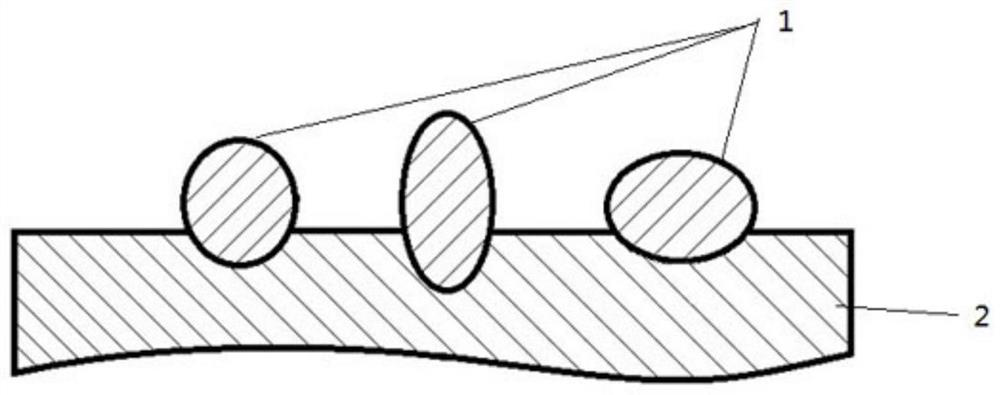Photocatalyst with function of releasing negative oxygen ions, and preparation method and application thereof
A photocatalyst and negative oxygen ion technology, applied in the field of photocatalytic materials, can solve the problems of easy sintering, uneven distribution, affecting catalytic activity and stability, etc.
- Summary
- Abstract
- Description
- Claims
- Application Information
AI Technical Summary
Problems solved by technology
Method used
Image
Examples
Embodiment 1
[0082] Mix nano-titanium dioxide (particle size below 100nm, the same below) with polyethylene glycol (molecular weight: 600), and then mix with pseudo-boehmite, nitric acid, and water, and then mix nano-titanium dioxide, pseudo-boehmite (with alumina ), nitric acid, and water are mixed in a weight ratio of 15:3:2:15, and the amount of polyethylene glycol added is added according to 3% of the weight of the mixed slurry of titanium dioxide and aluminum oxide to obtain a mixed slurry of titanium dioxide and aluminum oxide;
[0083] Spray the mixed slurry of titanium dioxide and alumina on cordierite honeycomb ceramics, perform unsaturated spray dipping according to 70% of the absorption rate, then dry at 70°C for 4 hours, bake at 280°C for 3 hours, and bake at 600°C 3 hours, obtain the honeycomb ceramic carrier A of loading modifying agent;
[0084] Immerse the honeycomb ceramic carrier A loaded with the modifier into titanium sol for vacuum impregnation, remove excess slurry, t...
Embodiment 2
[0089] Mix nano-titanium dioxide with polyethylene glycol (molecular weight: 600), and then mix with pseudo-boehmite, nitric acid, and water. Nano-titanium dioxide, pseudo-boehmite (based on alumina), nitric acid, and water The mixing ratio is 15:3.5:2:18, and the amount of polyethylene glycol is added according to 2.5% of the weight of the mixed slurry of titanium dioxide and aluminum oxide to obtain a mixed slurry of titanium dioxide and aluminum oxide;
[0090] Spray and impregnate the mixed slurry of titanium dioxide and alumina on the cordierite honeycomb ceramics, perform unsaturated spray impregnation according to 70% of the absorption rate, then dry at 70°C for 4 hours, bake at 260°C for 3 hours, and bake at 650°C 3 hours, obtain the honeycomb ceramic carrier B of loading modifying agent;
[0091] Immerse the modifier-loaded honeycomb ceramic carrier B in the titanium sol for vacuum impregnation, remove excess slurry, then dry at 70°C for 4 hours, repeat this step once...
Embodiment 3
[0096] Nano-titanium dioxide is mixed with polyethylene glycol (molecular weight is 400), and then mixed with pseudo-boehmite, nitric acid, and water, and nano-titanium dioxide, pseudo-boehmite (calculated as alumina), nitric acid, and water are mixed by weight The mixing ratio is 15:3.5:2:18, and the amount of polyethylene glycol is added according to 2.5% of the weight of the mixed slurry of titanium dioxide and aluminum oxide to obtain a mixed slurry of titanium dioxide and aluminum oxide;
[0097] Spray and impregnate the mixed slurry of titanium dioxide and alumina on the cordierite honeycomb ceramics, perform unsaturated spray impregnation according to 70% of the absorption rate, then dry at 70°C for 4 hours, bake at 250°C for 3 hours, and bake at 650°C 3 hours, obtain the honeycomb ceramic carrier C of loading modifying agent;
[0098] Immerse the honeycomb ceramic carrier C loaded with the modifier into the titanium sol for vacuum impregnation, remove excess slurry, th...
PUM
| Property | Measurement | Unit |
|---|---|---|
| Thermal conductivity | aaaaa | aaaaa |
| Density | aaaaa | aaaaa |
| Aperture | aaaaa | aaaaa |
Abstract
Description
Claims
Application Information
 Login to View More
Login to View More - R&D
- Intellectual Property
- Life Sciences
- Materials
- Tech Scout
- Unparalleled Data Quality
- Higher Quality Content
- 60% Fewer Hallucinations
Browse by: Latest US Patents, China's latest patents, Technical Efficacy Thesaurus, Application Domain, Technology Topic, Popular Technical Reports.
© 2025 PatSnap. All rights reserved.Legal|Privacy policy|Modern Slavery Act Transparency Statement|Sitemap|About US| Contact US: help@patsnap.com



